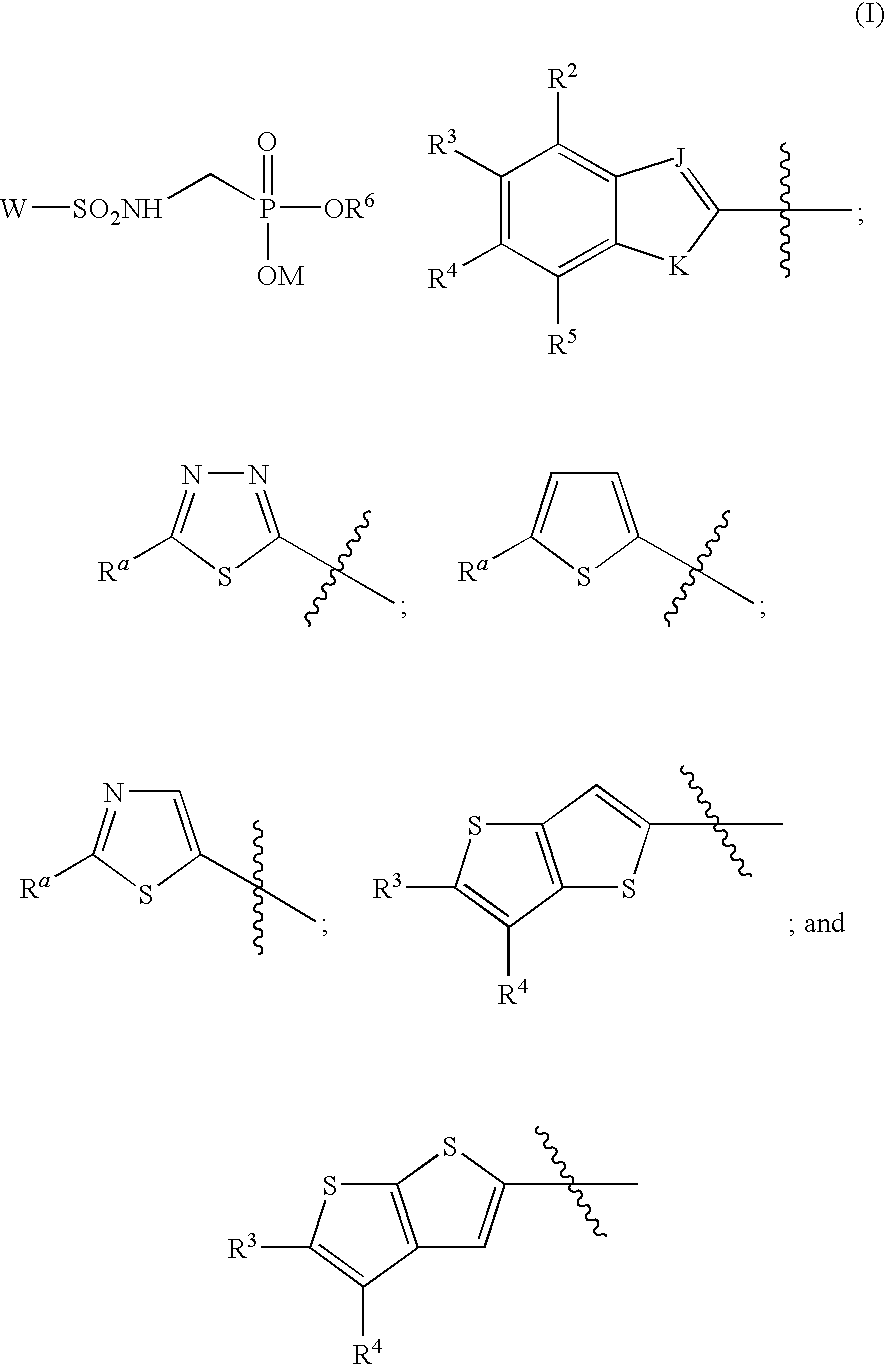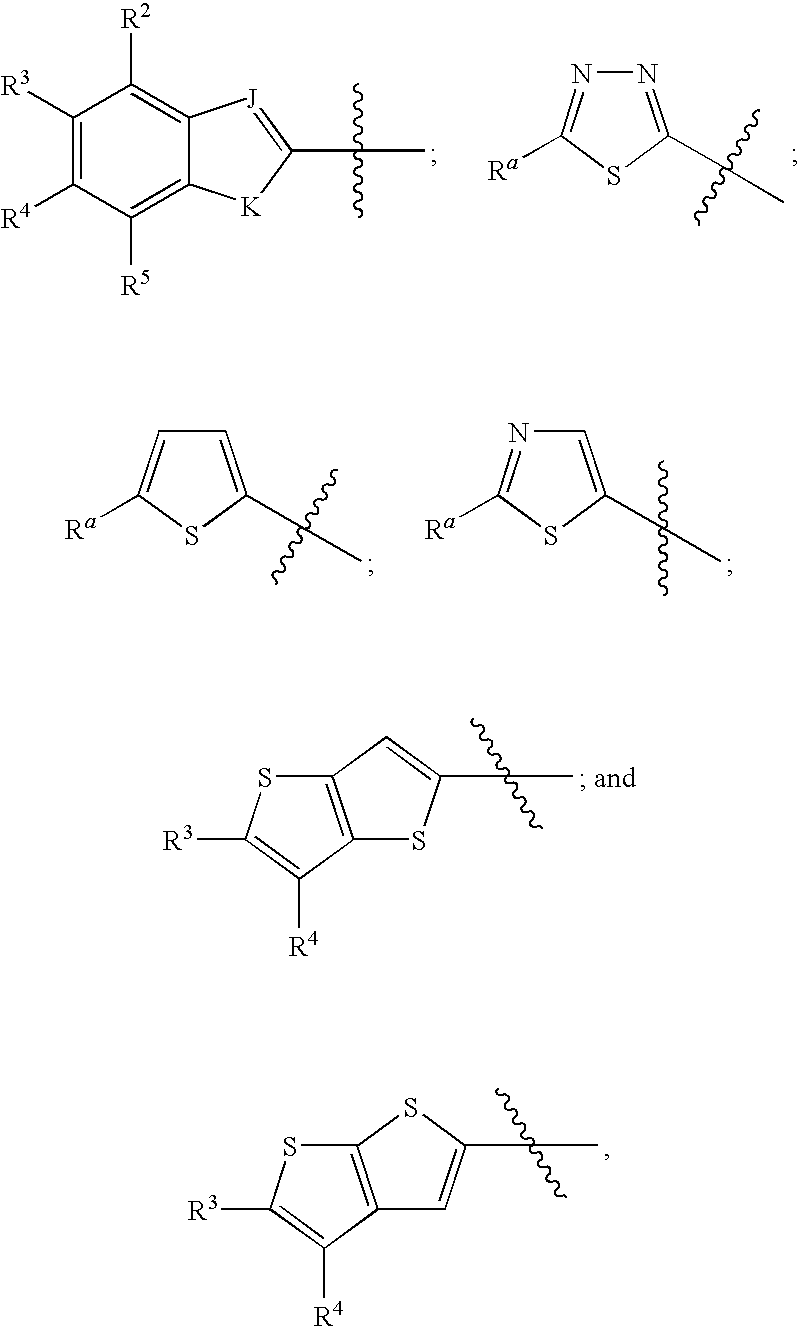Novel inhibitors of beta-lactamase
- Summary
- Abstract
- Description
- Claims
- Application Information
AI Technical Summary
Benefits of technology
Problems solved by technology
Method used
Image
Examples
example 37
Preparative Example 37
5,6-BIS(2-CHLOROETHOXY)BENZO[D]THIAZOLE-2-THIOL
[0386]To 5,6-bis(2-chloroethoxy)benzo[d]thiazole (2.4 g, 8.2 mmol) in THF (100 mL) was added n-butyllithium (2.5 M in hexanes, 4.1 mL, 10.3 mmol) dropwise, at −78° C. The mixture was stirred for 30 min, then sulfur (1.25 g, 39.0 mmol) suspended in THF (5 mL) was added, and the mixture was stirred for a further 30 min at −78° C. The reaction was quenched with ˜1 mL saturated ammonium chloride and concentrated under reduced pressure. The residue was partitioned between aqueous sodium hydroxide (1M) and ethyl acetate, and the combined aqueous layers were acidified with hydrochloric acid (1M), extracted with ethyl acetate, washed with aqueous ammonium chloride, dried over magnesium sulfate, and concentrated. The crude product was triturated with 1:1 dichloromethane / hexanes to provide the product as a colorless solid.
[0387]1H NMR (400 MHz, DMSO-d6) δ (ppm): 13.59 (br s, 1H); 7.42 (s, 1H); 6.88 (s, 1H); 4.27-4.21 (m, 4H)...
example 38
Preparative Example 38
DIETHYL (5,6-BIS(2-CHLOROETHOXY)BENZO[D]THIAZOL-2-YLTHIOAMINO)-METHYLPHOSPHONATE
[0391]To 5,6-bis(2-chloroethoxy)benzo[d]thiazole-2-thiol (1.10 g, 3.39 mmol) in DME (10 mL) was added aqueous sodium hydroxide (1.25 M, 5.4 mL, 6.8 mmol) and the mixture was diluted to 25 mL with water. Sodium hypochlorite (12% solution, 2.4 mL, 0.29 g, 3.9 mmol) was diluted with water (25 mL). These two solutions were added simultaneously, dropwise, to a stirred solution of diethyl aminomethylphosphonate oxalate (2.10 g, 8.17 mmol) and aqueous sodium hydroxide (1.25 M, 6.6 mL, 8.2 mmol) in DME (10 mL), at 0° C., over ˜10 min. The mixture was stirred for 10 min, and then the DME was removed under reduced pressure. The residue was partitioned between water and ethyl acetate, and the combined organic extracts were washed with saturated ammonium chloride and brine, dried over magnesium sulfate, and concentrated. Column chromatography (ethyl acetate) provided the product.
[0392]1H NMR (4...
example 39
Preparative Example 39
General Preparation of Benzothiophenes
METHOD A. 3-METHYL-5-METHOXY-1-BENZOTHIOPHENE
[0396]To a stirred, freshly prepared solution of 4-methoxybenzenethiol (10 mL, 81.1 mmol) in 200 mL acetone at room temperature was bubbled in nitrogen gas for 10 mins. To this stirred solution was added K2CO3 (11 g, 81.1 mmol) and chloroacetone (6.8 mL, 85.2 mmol). The nitrogen bubbling was stopped and the reaction mixture was stirred overnight at room temperature. The reaction mixture was filtered and the filtrate was partitioned between saturated aqueous NaHCO3 solution and EtOAc. The layers were separated and the aqueous layer was extracted again with EtOAc. The combined organic layers were dried over MgSO4, filtered, and the filtrate evaporated in vacuo. The resulting solid was dissolved in toluene and slowly added to the mixture of PPA (15 g) and toluene at 125° C. in a two-neck round bottom flask fitted with a condenser. The reaction mixture was refluxed overnight and then...
PUM
| Property | Measurement | Unit |
|---|---|---|
| Mass | aaaaa | aaaaa |
| Molar density | aaaaa | aaaaa |
| Molar density | aaaaa | aaaaa |
Abstract
Description
Claims
Application Information
 Login to View More
Login to View More - R&D Engineer
- R&D Manager
- IP Professional
- Industry Leading Data Capabilities
- Powerful AI technology
- Patent DNA Extraction
Browse by: Latest US Patents, China's latest patents, Technical Efficacy Thesaurus, Application Domain, Technology Topic, Popular Technical Reports.
© 2024 PatSnap. All rights reserved.Legal|Privacy policy|Modern Slavery Act Transparency Statement|Sitemap|About US| Contact US: help@patsnap.com










